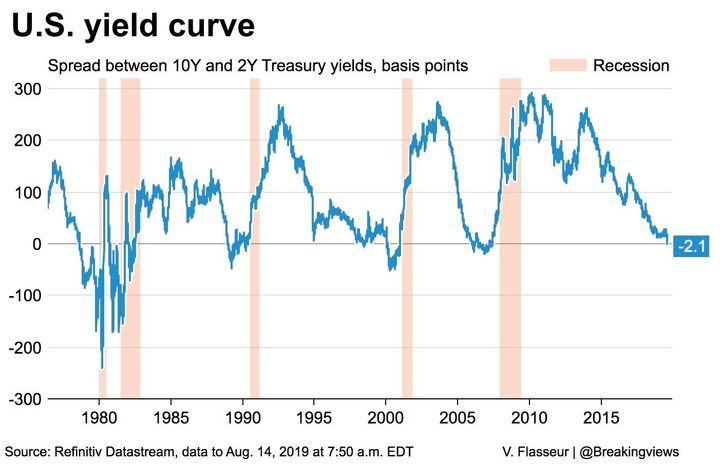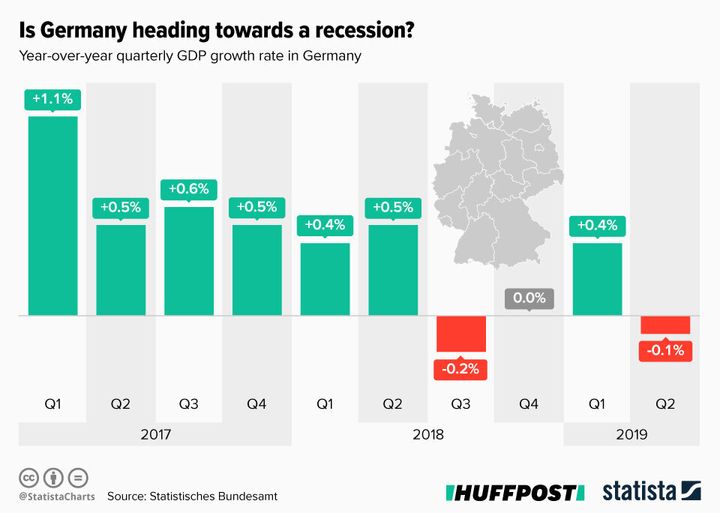If you happened to glance in on the New York Stock Exchange today, you’d notice most of the people in there look a little stressed.
What’s causing such obvious signs of tension? Well, something called the “inverted yield curve” has spooked the economic markets and there are whisperings of a global recession on the horizon – here’s British journalist Andrew Neil tweeting about it this morning.
Sounds gloomy, and it very well could be, but chances are you have no idea what he’s on about.
So unless you have a degree in economics, let HuffPost UK guide you through what it all means in a way that won’t make your head hurt.

First things first...
To begin, it’s worth explaining what a bond is.
When someone really big, like a government, needs a loan, they don’t just pop down to a high street bank and ask for some money. Instead they issue a bond for say £100m, and someone else buys it – let’s imagine that’s you.
Economist Duncan Weldon, tells HuffPost UK: “This is essentially seen as risk-free or as close as you can get to a risk-free return, by lending money to the UK or US government.”
This gives the government some cash to spend and in return, you get a set amount of money as interest - usually every six months, plus a payout when the bond matures.
Matures?
Yes, bonds are issued over set time limits, anything from one month to 30-plus years. The longer the bond, the more money you can expect as your investment is being tied up for longer and there is more risk of something going wrong.
This interest is called the coupon because in times gone by, they actually were paper coupons that you’d cut off and take down to the bond issuer, hand in and get some money in return.
Crucially, the coupon is a fixed amount so the return on a bond depends on how much you pay for it.
What affects the price of a bond?
Bonds can be sold on after they’re initially purchased and their price fluctuates depending on supply and demand.
Because buying a bond is usually a long-term commitment with moderate but steady returns, they’re not as exciting as buying shares on the stock market which, if you’re extremely lucky, can make you very rich very quickly.
So when the stock market is booming, like it has been recently, investors rush in to try and take advantage.
But if there’s a wobble in the stock market, investors will rush to put their money into bonds where it’s a bit safer.
More people buying bonds means they become more expensive – supply and demand.
Here’s Weldon again with an example of how it works:
“If a bond is worth £100 and has a £10 coupon then the yield is 10 percent.
“If the price of that bond falls to £50 but it’s still paying out £10 a year, then the yield is now 20 percent.
“If the price of that bond rises to £200 and it’s still paying out £10 then the yield is five percent.”
So what’s this ‘curve’ business then?
If you remember, bonds can be issued over different time periods and if investors are expressing a preference for one over the others it can give an insight into how much faith they have in a government’s ability to pay them back.
“There are various ways to look at it, you can look at three years vs five years, ten years vs 30 years,” says Weldon. “But the indicator that people tend to focus on, the one that’s got all the attention this week in the UK and the US, is the two year vs ten years.
“In absolute layman’s terms this means the interest rate on a two year bond is higher than the interest rate on a ten year bond which is unusual as most of the time you’d expect the interest rates on a longer term debt to be higher than on shorter term debt.”
Why is it a big deal?
An inverted yield curve is an indication that investors want the security of longer term investments because they are worried about the shorter term health of the economy.
In the US, the inversion of the two year and ten year bond yields has been a very reliable predictor of recessions over the last few decades and on Wednesday it inverted briefly for the first time since 2007.

So there’s going to be a recession?
In short, no one can say for certain.
“In the US, the yield curve has been a very, very good indicator of recession,” says Weldon. “An inversion in the two-ten year curve has I think pretty much always, post WW2, been followed by recession.
“But we should be clear, we’re talking about seven or eight recessions, so it’s not an economic indicator with hundred and hundreds of data points, we’re talking about a fairly small sample here.
“Secondly, outside of the US it’s never been a bad indicator, but the record is not fool-proof. Japan has had several recessions over the past few decades without a yield curve inversion.”
There are other signs of trouble though – weak economic data from Germany and China added to recent signals of a global slowdown.

That spooked investors, who responded by dumping stocks, sending the Dow Jones Industrial Average into an 800-point skid, its biggest drop of the year.
The S&P 500 index dropped nearly 3% as the market erased all of its gains from a rally the day before.
The losses come a day after stocks rallied when the Trump administration delayed tariffs on about 160 billion US dollars in Chinese goods that were set to take effect on September 1.
President Donald Trump took to Twitter to defend his trade policy Wednesday, saying: “We are winning big time, against China.”
But many on Wall Street remain worried that the trade war between the world’s two largest economies may drag on through the 2020 US election and cause more economic damage.
“We still see a substantial risk that the trade dispute will escalate further,” said Mark Haefele, global chief investment officer at investment bank UBS in a note to clients.
Trump also criticised the Federal Reserve for hamstringing the US economy by raising rates “too much & too fast” last year and not reversing its policy aggressively enough — the Fed cut its key rate by a quarter point last month.
